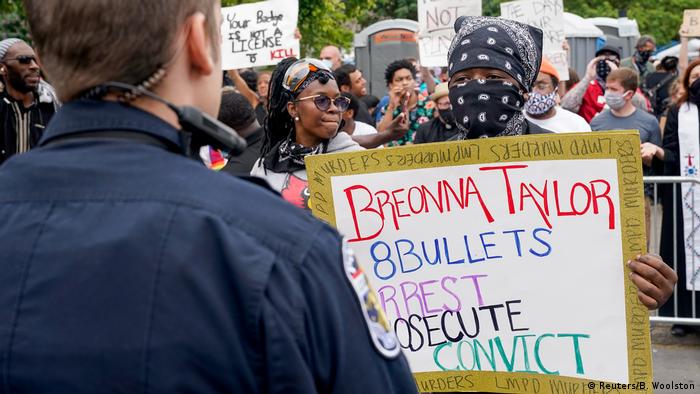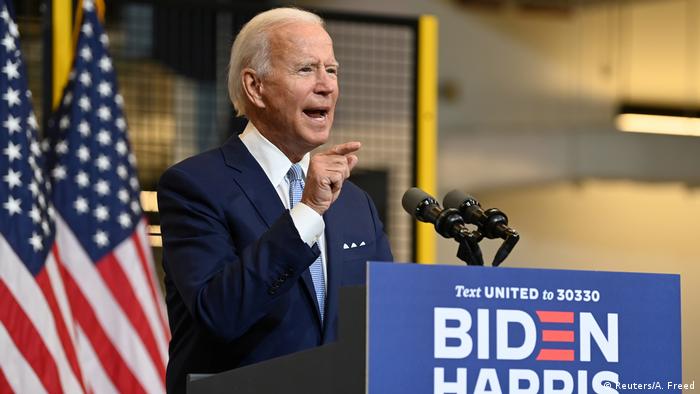US election: Trump bets on law-and-order campaign, again
The US president has once again opted for polarization in his reelection bid. This time, he attempts to capitalize on the – often violent – protests against police brutality by prioritizing law and order.
Breonna Taylor was fast asleep in her bedroom when in the middle of the night on March 13, police kicked in the door, barged into the hallway unannounced and raided her apartment, carrying out a so-called "no-knock" warrant in a narcotics investigation.
No drugs were found in Taylor's apartment. The warrant had been issued for a different person, police had the wrong address. Breonna Taylor was shot eight times. She was 26 years old when she died.
An investigation into the conduct of the police officers involved in the incident is ongoing and six officers from the Louisville Metro Police Department in Kentucky are currently under internal investigation. However, until now, no charges have been filed, no arrests have been made.
Taylor's mother filed a wrongful death lawsuit against the city of Louisville and — more than six months later — the city's mayor announced he had reached a settlement with the victim's family. Louisville will pay $12 million (€10,1 million) in damages to Taylor's family.

Initial protests in Louisville, Kentucky were relatively small and peaceful
BLM protests initially on no one's radar
In the aftermath of Taylor's death, protesters almost immediately took to the streets in Louisville and elsewhere in the country. Earlier this year, most of these protests were relatively small in numbers and mostly peaceful.
Read more: US Attorney General Barr denies systematic racism in police shootings
Disproportionate behavior, misconduct and violence by police officers against black Americans in numerous cases before Breonna Taylor's death, what many perceive as structural and systemic racism in the US and the Black Lives Matter (BLM) movement — these phenomena and problems have now become part of the daily national discourse.
Just six months ago, hardly any of these topics registered high on the national news media's radar — nor were they part of any Trump or Biden campaign speeches until recently. It is fair to assume that none of these issues were to be found on any party's campaign strategy paper. The coronavirus pandemic was America's and the candidates' focus.
The death of George Floyd
Minneapolis, Minnesota, May 25, changed all of that. A video showing the death of George Floyd in police custody led almost instantly to an explosion of outrage in many cities across the US and in some other parts of the world.
Read more: Protesters take to the streets of France, Germany over police brutality
Protests quickly turned into riots in Minneapolis. As soon as torching and looting of private and public properties and businesses started, the nation and the world took notice — as did President Donald Trump and his campaign managers.
By May 29, President Trump had identified what happened in Minneapolis, and what was beginning to grip the country like a wildfire, as an opportunity to politically position himself as the last man standing against an onslaught of chaos and turmoil. The president started using the protests, violence and rioting as a polarizing tool in his bid for reelection in November.
On Twitter — his favorite means of communicating — he decried a "total lack of leadership" in Minnepaolis and promised to "send in the National Guard and get the job done right."
In another tweet on the same day, he threatened that "when the looting starts, the shooting starts."
Trump 'using scare tactics for Americans'
John Hudak, senior fellow in governance studies and deputy director of the Center for Effective Public Management at the Brookings Institution in Washington describes how the President utilizes violent protests against police brutality and racial inequality for his campaign purposes.
Read more: How people of color experience living in Germany
"He is doing it by using scare tactics for Americans, suggesting that this type of behavior is generated by Democrats and Democratic supporters," Hudak told DW. "He suggests that his approach to law and order is the stronger one, the more effective one. And that if Americans fear those types of behavior, they need to stick with his policies."
In just 15 days between George Floyd's deadly encounter with police and his funeral on June 9, one fourth of President Trump's tweets had focused on unrest, law and order, and the threat of using the military against protesters, according to an analysis by US daily USA Today.
A return to 2016 tactics
Hudak adds that Donald Trump's strategy is by no means new. "The president is focusing on a divisive message that pits usually white Americans against other groups. He did this in 2016 and he is doing it again."
The difference to 2016 is that then-Republican Party presidential candidate Donald Trump stoked the flames of fear in Americans by painting a picture of hordes of illegal immigrants about to flood the United States of America.
"Now he is doing it with regard to individuals in urban areas, particularly black Americans," Hudak said.
Trump attempts to 'stoke the flames of racial bias'
What about Trump's challenger? Democratic Presidential candidate Joe Biden and his campaign strongly denounced the President's divisive rhetoric, but Hudak thinks Democrats have to do more.

Joe Biden will have to convince voters that he has an alternative to Trump's law-and-order approach
"They need to talk about what they will do in the cities, in the communities, the message to black and Latino voters cannot simply be, this guy is bad, so vote for me," he said.
No matter how successful or unsuccessful the President's tactics prove to be come November 3, many liberal political observers across the political fault lines agree with Hudak on one thing.
"The attempt to stoke the flames of racial bias, and flat-out racism, is something that is deeply unnerving in this country (…) and there is a real social cost to this type of behavior from the president."
For Brian Trascher, a Trump campaign surrogate and member of the Trump Campaign Victory Finance Committee, people like Brookings' John Hudak and others have it entirely wrong.
"The notion that the President is stoking the flames is completely inaccurate," he insists, adding that there is no law-and-order strategy.
"It's the president just making clear where he stands on law and order. He's with the police, he is not for defunding the police, he is not for attacking the police," Trascher explained.
Dividing America has worked for a president before
Some experts have noted that Trump's tone is similar to that of ex-US President Richard Nixon.
Read more: Donald Trump and Richard Nixon: Parallels between Russia and Watergate
In 1968 Nixon ran for president, positioning himself strongly against anti-war-protests and against race riots, which had occurred in cities across the country, winning him the presidency.
John Hudak doubts this strategy will work for President Trump, because "Donald Trump is trying to convince Americans that while these things are happening under his watch and while they should be very afraid of what is happening under his watch, the only solution is to allow him to govern."
A problem with this is that "when this message has been effective in history, it is usually a challenger using this message against an incumbent, because the activities happen under that incumbent," Hudak added.
tinyurlis.gdu.nuclck.ruulvis.netshrtco.de
